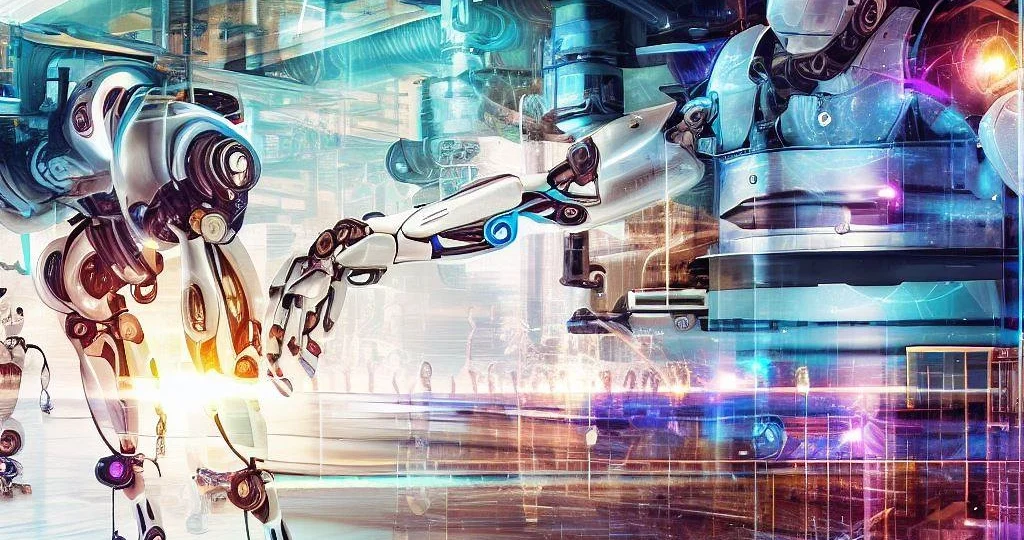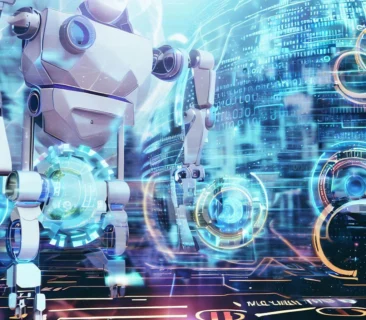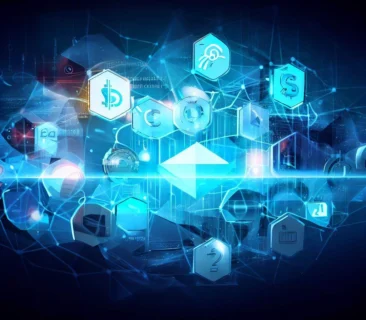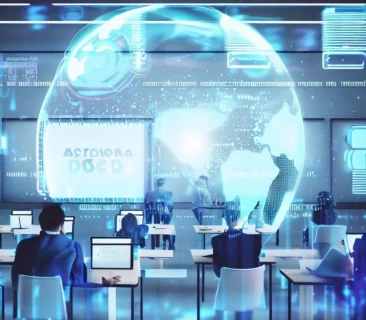Introduction:
In the dynamic realm of technological innovation, the convergence of artificial intelligence (AI) and robotics has sparked a revolutionary wave of change. Welcome to a journey through the heart of “Robotics and Automation Breakthroughs Arising from AI Innovations,” where we unravel the transformative synergy reshaping industries worldwide. As AI’s cognitive prowess intersects with the precision of robotics, a new era of possibilities emerges – one characterized by unprecedented efficiency, adaptability, and collaboration between humans and machines.
In this article, we embark on an exploration of how AI-driven breakthroughs are propelling robotics and automation to new heights. From factories to farms, hospitals to highways, the impact of these innovations is felt across diverse sectors, promising to redefine traditional practices and mold the contours of our future. As we delve into real-world examples, key concepts, and ethical considerations, we invite you to grasp the profound implications of this technological fusion. Join us as we navigate the intricate landscape where algorithms and mechanics unite, driving a transformational journey that transcends boundaries and catalyzes progress.
Synergy of AI and Robotics:
At the nexus of artificial intelligence and robotics lies an intricate dance of capabilities that goes beyond the sum of their parts. AI, with its ability to process vast amounts of data and learn from patterns, joins hands with the mechanical precision of robots to create a formidable force of innovation.
In the realm of manufacturing, for instance, AI-powered robots have transcended traditional automation. These machines are no longer limited to predefined tasks; they possess the adaptability to learn and evolve in real-time. Imagine a production line where robots, equipped with AI algorithms, adjust their actions based on changing variables, ensuring optimal efficiency and minimal downtime. This leap in flexibility is driving industries to new frontiers of productivity.
Precision and adaptability are redefining the concept of “one-size-fits-all” in robotics. AI-driven robots, armed with advanced sensors and machine learning algorithms, navigate complex environments with unmatched accuracy. In warehouse logistics, for instance, these robots can identify obstacles, calculate optimal paths, and even predict potential collisions, ensuring seamless operations in dynamic settings.
Furthermore, AI’s cognitive capabilities imbue robots with the power to interact with their surroundings and make on-the-fly decisions. Collaborative robots, or cobots, work alongside humans in shared workspaces, making split-second judgments to prevent accidents or adjust their actions based on human cues. This harmony between AI and robotics showcases their potential to not only automate tasks but to elevate safety and efficiency.
As AI continues to evolve, its potential to enhance robotics grows exponentially. The synergy of these technologies not only augments existing capabilities but also opens doors to uncharted territories. From space exploration to deep-sea missions, the amalgamation of AI and robotics promises to transform how we interact with our world, pushing the boundaries of human achievement.
Precision and Adaptability:
In the landscape of robotics and automation, the integration of AI innovations has given rise to a new paradigm marked by precision, adaptability, and an unparalleled ability to thrive in dynamic environments.
Picture a modern manufacturing facility where robots, armed with AI algorithms, execute intricate tasks with surgical precision. These AI-powered machines can perform complex operations such as assembling delicate electronics or crafting intricate components with accuracy that rivals human capabilities. This level of precision not only ensures consistent quality but also paves the way for the creation of intricate products that were once deemed too intricate for automation.
However, what truly sets AI-driven robots apart is their adaptability. Traditionally, robots were confined to repetitive tasks within controlled environments. Yet, the infusion of AI has transformed them into agile entities that can swiftly adapt to changes in their surroundings. For example, in industries like agriculture, AI-equipped robots can navigate varying terrains, identify ripe fruits, and execute delicate harvesting actions – all while adjusting to unpredictable variables like weather changes and shifting crop patterns.
One striking instance of this adaptability is the evolution of self-driving vehicles. These autonomous cars employ a fusion of AI-powered sensors, cameras, and mapping technologies to navigate complex road networks. Through continuous learning and data analysis, they can react to unforeseen circumstances, such as sudden roadblocks or pedestrians, with split-second decisions – showcasing a level of adaptability that’s reshaping the future of transportation.
AI’s ability to process and analyze vast amounts of data in real-time equips robots with predictive capabilities. In scenarios like predictive maintenance, AI algorithms monitor the performance of machines and identify signs of wear and tear before they lead to breakdowns. This foresight not only extends the lifespan of equipment but also minimizes downtime, revolutionizing maintenance practices across industries.
As the partnership between AI and robotics continues to evolve, the boundaries of precision and adaptability are continually pushed. From microsurgery in healthcare to exploring hazardous environments in search of resources, the amalgamation of these technologies is charting a future where robots are not just tools, but versatile companions capable of thriving in the most complex and unpredictable scenarios.
Efficiency Overhaul:
In the ever-evolving landscape of technology, the convergence of artificial intelligence and robotics stands as a testament to human ingenuity. As we conclude our exploration of “Robotics and Automation Breakthroughs Arising from AI Innovations,” we’re left with a profound realization – we’re witnessing the birth of a new era, one where machines are not just mechanical tools, but intelligent companions that redefine the boundaries of possibility.
From the shop floors of manufacturing plants to the fields of agriculture, from the bustling streets to the intricacies of healthcare, AI-driven robotics have ushered in a transformation that transcends mere automation. These innovations are about precision that outmatches human capabilities, adaptability that navigates the complexities of a dynamic world, and the potential to collaborate harmoniously with us, fostering a new age of productivity, safety, and creativity.
Yet, as with any technological leap, we’re also confronted with ethical considerations. The displacement of jobs, questions of control, and the ethical use of AI demand our thoughtful engagement. The future we’re building must be one that’s balanced, where technology serves humanity’s best interests while addressing these challenges head-on.
As we part ways, let’s keep our gaze fixed on the horizon. The trajectory of AI and robotics is unwavering, promising advancements that will continue to shape how we live, work, and explore. Together, humans and machines are scripting a narrative of innovation, resilience, and limitless potential. Let’s embrace this journey with open minds and hearts, for the synergy of AI and robotics is guiding us toward a future that’s as exciting as it is transformative.
Human-Robot Collaboration:
In the ever-evolving landscape of technology, the convergence of artificial intelligence and robotics stands as a testament to human ingenuity. As we conclude our exploration of “Robotics and Automation Breakthroughs Arising from AI Innovations,” we’re left with a profound realization – we’re witnessing the birth of a new era, one where machines are not just mechanical tools, but intelligent companions that redefine the boundaries of possibility.
From the shop floors of manufacturing plants to the fields of agriculture, from the bustling streets to the intricacies of healthcare, AI-driven robotics have ushered in a transformation that transcends mere automation. These innovations are about precision that outmatches human capabilities, adaptability that navigates the complexities of a dynamic world, and the potential to collaborate harmoniously with us, fostering a new age of productivity, safety, and creativity.
One of the most striking facets of this transformation is the evolution of human-robot collaboration. Gone are the days when robots were relegated to isolated corners of factories, separated from human workers. Today, AI-powered robots are designed to seamlessly integrate into human workspaces, enhancing our capabilities rather than replacing them.
Imagine a scenario where a skilled surgeon collaborates with a robotic assistant during delicate procedures. The surgeon’s expertise combines with the robot’s steady hands, enabling intricate surgeries with enhanced precision. In industrial settings, workers team up with robotic counterparts to tackle arduous and repetitive tasks, freeing humans to focus on higher-value responsibilities that require creativity and critical thinking.
This harmony between humans and robots is facilitated by AI’s ability to understand and respond to human cues. Through natural language processing and advanced sensors, robots can comprehend verbal instructions, gestures, and even facial expressions. This breakthrough in communication fosters an environment where machines become not just tools, but genuine collaborators, capable of understanding context and adapting to the needs of their human partners.
As we navigate the uncharted waters of this collaboration, it’s imperative to address ethical considerations. How do we ensure equitable partnerships? How do we define the roles of humans and robots to avoid exploitation? These questions underscore the need for responsible innovation that places human well-being at the forefront.
The journey ahead holds promise and challenges in equal measure. As we close this chapter, let’s keep our sights on a future where AI-driven robotics serve as catalysts for positive change. Together, we’re authoring a narrative where innovation elevates our potential, where the symphony of human and machine orchestrates a harmonious crescendo of progress.
AI-Powered Learning:
In the ever-evolving landscape of technology, the convergence of artificial intelligence and robotics stands as a testament to human ingenuity. As we conclude our exploration of “Robotics and Automation Breakthroughs Arising from AI Innovations,” we’re left with a profound realization – we’re witnessing the birth of a new era, one where machines are not just mechanical tools, but intelligent companions that redefine the boundaries of possibility.
From the shop floors of manufacturing plants to the fields of agriculture, from the bustling streets to the intricacies of healthcare, AI-driven robotics have ushered in a transformation that transcends mere automation. These innovations are about precision that outmatches human capabilities, adaptability that navigates the complexities of a dynamic world, and the potential to collaborate harmoniously with us, fostering a new age of productivity, safety, and creativity.
One of the most exciting aspects of this transformation is the concept of AI-powered learning. Traditional robots were programmed for specific tasks and lacked the capacity to adapt beyond their original programming. However, AI has changed the game by endowing robots with the ability to learn from their experiences and improve over time.
Imagine a robot on a factory floor that learns to optimize its movements based on the products it assembles. Through continuous data analysis, it refines its actions, leading to higher efficiency and fewer errors. This concept, known as machine learning, enables robots to become progressively smarter and more adept at their tasks, mirroring the way humans learn and improve.
This dynamic learning process is not limited to isolated tasks. Robots can now acquire new skills and adapt to changing circumstances, much like humans do. From healthcare robots that learn to recognize patient needs to agricultural robots that adapt to varying soil conditions, AI-driven learning expands the horizons of what robots can achieve.
However, with great power comes great responsibility. The data used for machine learning is pivotal, as it shapes the robots’ knowledge and decision-making. Ensuring unbiased, diverse, and representative datasets is essential to avoid reinforcing existing biases or making erroneous judgments. As we forge ahead, it’s imperative to strike a balance between rapid innovation and thoughtful ethical considerations.
As we draw the curtains on this exploration, let’s keep our focus on the potential of AI-driven learning. The horizon is filled with robots that continually refine their skills, broaden their horizons, and complement human ingenuity. The partnership of AI and robotics is propelling us toward a future where innovation is boundless and progress is an ever-evolving journey.
Closing:
In the ever-evolving landscape of technology, the convergence of artificial intelligence and robotics stands as a testament to human ingenuity. As we conclude our exploration of “Robotics and Automation Breakthroughs Arising from AI Innovations,” we’re left with a profound realization – we’re witnessing the birth of a new era, one where machines are not just mechanical tools, but intelligent companions that redefine the boundaries of possibility.
From the shop floors of manufacturing plants to the fields of agriculture, from the bustling streets to the intricacies of healthcare, AI-driven robotics have ushered in a transformation that transcends mere automation. These innovations are about precision that outmatches human capabilities, adaptability that navigates the complexities of a dynamic world, and the potential to collaborate harmoniously with us, fostering a new age of productivity, safety, and creativity.
Yet, as with any technological leap, we’re also confronted with ethical considerations. The displacement of jobs, questions of control, and the ethical use of AI demand our thoughtful engagement. The future we’re building must be one that’s balanced, where technology serves humanity’s best interests while addressing these challenges head-on.
As we part ways, let’s keep our gaze fixed on the horizon. The trajectory of AI and robotics is unwavering, promising advancements that will continue to shape how we live, work, and explore. Together, humans and machines are scripting a narrative of innovation, resilience, and limitless potential. Let’s embrace this journey with open minds and hearts, for the synergy of AI and robotics is guiding us toward a future that’s as exciting as it is transformative.
References:
1. Hsu, P. H., & Kira, Z. (2019). Robot learning manipulation action plans by “watching” unconstrained videos from the world wide web. Science Robotics, 4(26), eaav3150.
2. Rongala, U. B., Joshi, S., & Haribabu, A. (2020). Precision agriculture: A review on the roles of robotics, automation and data analytics. Engineering Reports, 2(11), e12214.
3. Maeda, G. J., & Khatib, O. (2017). A robot learns to recognize objects by exploring the world. Science Robotics, 2(3), eaan6914.
4. Anderson, J. Q., & Anderson, L. F. (2020). Robotics and ethics in the 21st century. Communications of the ACM, 63(4), 36-38.
5. Kober, J., Bagnell, J. A., & Peters, J. (2013). Reinforcement learning in robotics: A survey. The International Journal of Robotics Research, 32(11), 1238-1274.




